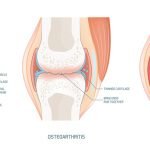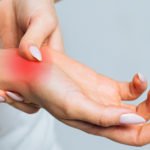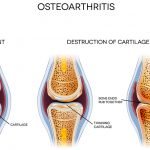Arthritis is a major complaint of many people as they get older. Typically starting after the age of 40, osteoarthritis—the most common form of arthritis—develops in one or more joints and results in pain, stiffness, and swelling, which can worsen to the point that it impacts the quality of life and eventually even becomes disabling. And with more than 30 million adults in the United States alone suffering from osteoarthritis, this is an issue that should be of concern to all of us. But even if you already have a diagnosis of osteoarthritis, there is hope. New research suggests that there may be a simple way to avoid a worsening of your symptoms.
The study, which took place at the Northwestern University Feinberg School of Medicine in Chicago, Illinois, found that taking a brisk walk for less than 10 minutes per day is associated with a decrease in the risk of developing a disability for those with osteoarthritis in a lower-extremity joint.1Dunlop, Dorothy, D.; et al. “One Hour a Week: Moving to Prevent Disability in Adults With Lower Extremity Joint Symptoms.” American Journal of Preventive Medicine. 19 March 2019. Accessed 7 April 2019. http://www.ajpmonline.org/article/S0749-3797(19)30045-5/fulltext. This is based on an investigation that included more than 1,500 men and women between the age of 45 and 79 and residing around Baltimore, Maryland; Columbus, Ohio; Pawtucket, Rhode Island; and Pittsburgh, Pennsylvania.
All the subjects had been diagnosed with osteoarthritis in the knee, hip, ankle, or foot, and experienced some level of pain or stiffness but were not limited in mobility or disabled in any way as the trial began. They were tracked for four years, with their physical activity recorded on a wearable electronic device. After evaluating the data, the researchers discovered that just one hour a week—or less than 10 minutes a day—of moderate to vigorous exercise was enough to lower their risk of disability substantially.
As the four-year time period ended, the participants were assessed as to their ability to perform a number of standard daily and self-care tasks. Among those who spent less than an hour a week doing moderate activity, 24 percent had to walk so slowly that it was unsafe to cross a street and 23 percent had trouble with basic tasks such as bathing and dressing unassisted. But those who had been doing a minimum of an hour a week of exercise had an 85 percent lower risk of being unable to cross a street alone due to the need to walk slowly, and their risk of being unable to bathe, dress, or walk across a room unaided was close to 45 percent lower.
Considering the fact that approximately 20 percent of osteoarthritis sufferers develop a disability over time, this is huge news. It may be intimidating for someone who rarely or never does any sort of exercise to hear that they should be working out for a half hour to an hour each week. But even if you are currently sedentary and don’t do anything more than walk around your home and to the door of your car, 10 minutes a day of walking is a realistic goal that you can absolutely achieve.
Don’t concern yourself too much with your pace initially. Simply start by putting on a comfortable pair of shoes and walking down the block, around the corner, or wherever you can make it in a few minutes. As this becomes a habit, you can work on extending the amount of time you spend walking and pick up your speed.
And don’t forget to take other steps to lower your risk of disability from osteoarthritis, such as eating foods that help reduce inflammation like nuts and losing weight, which will relieve some stress on your affected joints. To learn more about natural ways to reduce chronic joint pain, read Jon Barron’s article, “A Five-Pronged Approach to Chronic Joint Pain and Inflammation.”
References
| ↑1 | Dunlop, Dorothy, D.; et al. “One Hour a Week: Moving to Prevent Disability in Adults With Lower Extremity Joint Symptoms.” American Journal of Preventive Medicine. 19 March 2019. Accessed 7 April 2019. http://www.ajpmonline.org/article/S0749-3797(19)30045-5/fulltext. |
|---|










